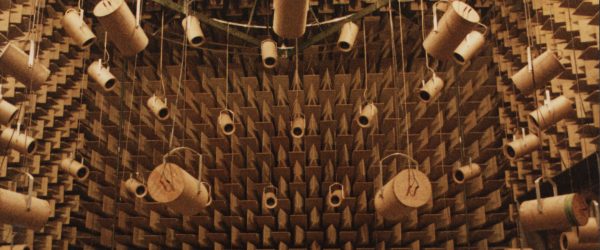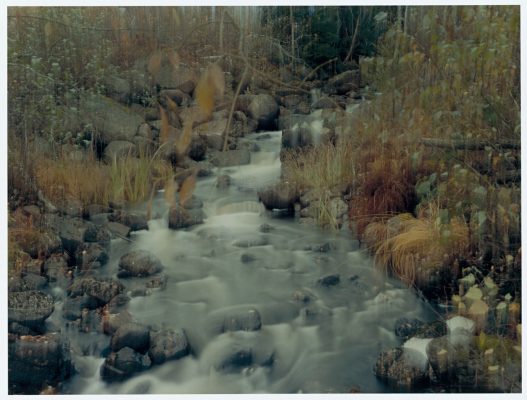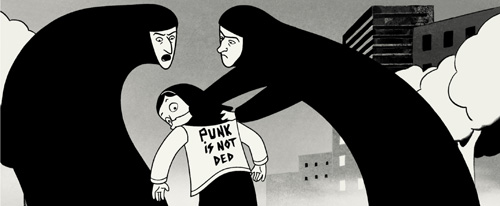The anechoic chamber at University College London has the clutter of a space shared by many people: styrofoam cups, defunct pieces of equipment in the long purgatory between the days of their use and their removal to the skip, and an accretion of still-living technical apparatus – amps, speakers and laptops – perched on narrow shelves. The inner, soundproof room is sparser, with a long-barrelled microphone and wedges of foam jagging out from every wall; these severe surfaces are counterpoised by an old wingback chair that sags as you sit in it. When the experimenter settles you and leaves, shutting the double doors firmly behind her, a feeling of numbness grows with the silence. When the lights are turned out, a thick skin of darkness settles.
The chamber has a wholly pragmatic function for psychologists and language researchers, as a place to record stimuli free from contaminating noise; my visit, however, was for a different purpose. I was poet-in-residence with the Speech Communication Laboratory at UCL’s Institute of Cognitive Neuroscience, and in June 2012 I spent an hour in the anechoic room. I had come for the silence, wanting to experience one of the quietest places in the city, but Nadine, one of the lab members, had said that plunging me into darkness for twenty minutes might help me to focus. And so she shut the double doors, and as I sat in the pitch black, trying to quieten my breathing, a world of sound flowered between my ears.
I have the recording I made inside the chamber when the twenty minutes was up. It’s a rambling monologue flecked with slip-ups, corrections and silences, as I try to gather up more scraps of the vanishing experience I’m trying to describe, caught by the way speech forces the silence it aims to document back into the realm of memory.
I know, because I can hear myself saying it, that I thought I heard a sound ‘like sand being thrown onto something metallic’ phasing in and out in my right ear; something like a persistent, twittering birdcall above me and to the right; and a dull sense of pressure encroaching from the left. There were other bodily failings: stomach creaks and gurgles, the wet crackle, ‘almost a crumpling tin foil’, of what I guessed were my Eustachian tubes, and the refrains of Neil Young and Take That songs that bobbed into my consciousness like bloated corpses.
The link between this mildly disconcerting experience and the making of poetry is perhaps not obvious, but this unusual acoustic space also resonates with legend. Just as the Castalian Spring at Delphi has been a mineral source for poets from Ovid and Shakespeare to Denise Riley, for whom it gets lyricists ‘gorgeous and pneumatic in the throat’, so the anechoic chamber is a kindred space, a kind of modernist cave of the oracle. It was at Harvard’s anechoic room, in the late forties or early fifties, that John Cage heard ‘one high and one low’ sound: his nervous system and his circulating blood, as the engineer supposedly told him. From this auricular experience, as Cage suggested in his lecture ‘Experimental Music’, two interpretations follow: one recognises the impossibility of subjective silence, and acknowledges the fundamental bruit that a living creature carries; the second, more contentious, demands that the composer attend to this unintended noise, and open ‘the doors of music to the sounds that happen to be in the environment’. The poetry I’m interested in making also turns to an expanded environment, taking its materials from the infelicities of speech, the accidental rough music which can be found in rhyme or in puns, or equally in the phatic melodies of ‘hmm’ and ‘err’. Unstructured noise is an important part of this: it may be obvious to say that poetry is torn between language as turbulent surface and language as vehicle of communication, but even if you let go of signification and dive into sound, meaning will bubble up again from next to nothing. People will extract sense from the most unpromising sources, and this can be the basis of a shared experience. This way of making is a tradition, too; one that presses the membrane of ‘poetry’ so close to those of composition, conceptual art, performance, lived speech or comedy, that with any luck they’ll merge.
But stepping into the anechoic chamber evokes another movement too: a displacement of poetry into the spaces of science. This was motivated by my long-term disciplinary kleptomania, born from a sense that there must be more to poetry than the endless recycling of ‘literary’ models or personal experience, and that poetry can only be kept new by a piratical plundering of other disciplines. But if this act of transport is to be more than a gimmick, the scientific cargo has to crack apart the poetry that tries to carry it so completely that you start to doubt anything useful will be salvaged. Only a thoroughgoing wreckage of the idea of the poem can disperse the ghost of tedium; a spectre which should haunt anyone who’s read the kind of poem that uses an fMRI scan or the idea of entropy as convenient figuration, an unexamined mass of science locked stolidly in the hold of a cast-iron personal lyric.
If the conjunction of poetry and science is to produce more than a wasted opportunity, in the sense of a meeting that changes nothing and leaves both parties mouthing platitudes about the importance of each other’s work, the place to start, from the poetic side, might not be with scientific products but with processes, languages, techniques and equations; the messy, contested and uncertain couriers of knowledge. The brain scan might present itself as a rebus of truth-telling, of mind-reading – but this self-contained image is produced through a tangled web of procedures and principles, which range from the behaviour of nuclei within magnetic fields and the relationship between brain activity and blood-flow to the statistical procedures used to reduce noisy ‘artefacts’ and the design of the experiments themselves.
The kind of approach I’m interested in developing has grown through discussing or reading the work of friends and peers, such as Sandra Huber’s residency with a sleep lab in Lausanne or James Harvey’s poems exploring scientific formulae. The work that Sandra made for her residency focused on the experiment as performance, or used the graph of her sleep patterns as a formal constraint for writing, whereas James, who died last year, was a biologist by training who produced fascinating pared-down forms for textual and visual poetry from a close engagement with mathematical equations or the principles of objective description.
To my mind though, one of the most conceptually complete attempts to rethink poetry with and through the life sciences has been Christian Bök’s Xenotext project, which is now entering its final stages. For this, the poet designed a text which he has encrypted into a bacterium’s DNA as a sequence of codons, or triplets of DNA. This sequence is then used by the bacterium to produce a viable protein which, when translated back from its amino acids to letters via Bök’s encoding, forms a second meaningful poem produced in ‘response’. The skill and time required to select the pairing of letters to codons, and to produce two meaningful poems through the double-translation of letter to codon, to amino-acid, to new letter, is mind-boggling. On top of this, Bök has had to teach himself the necessary molecular biochemistry and genetic engineering techniques, claiming that learning these skills was ‘part of the artistic exercise’. It’s impossible not to admire the poem’s virtuoso feat of composition, and the project’s deep engagement with the material and practice of biology to produce new forms for poetry. And yet when I saw Bök give a lecture in London in 2011, I was surprised to hear him professing the immortal value of literature: the only markers of human life that will outlast us, he said, are the indices of globally altered temperatures and permanently increased radiation levels; what if poetry could be added to that? It seems strange that such a deeply romantic idea has survived its immersion in biology, but I suppose any engagement between poetry and science walks a tightrope between two strong gravitational forces, whirlpools formed from the expectations, values and historical inertias of the two communities which it attempts to balance.
The anechoic chamber is one of the many spaces that the Speech Communication Lab uses in the complex process of producing scientific knowledge: entering that space meant I could borrow more than language or metaphor from their work. The physical context of the soundproof room, the inbuilt mikes which recorded my voice, the principle of ‘bracketing’ a subject off from outside influences, to control or at least dampen environmental inputs: all of these elements have been diverted from their original scientific use and turned towards making poetry. The outcome, though, is just a few minutes of speech. The challenge that I’m addressing now is how to work with this source material, and open out its potential, through a series of procedures that I consider to be experiments (in a literary rather than a scientific sense; I mean that the outcomes are not determined in advance, and that they carry the possibility of failure.)
My first attempt started from a poem that I wrote whilst I was still in the anechoic chamber, a close translation of the sounds I’d experienced in that state of aural deprivation.
starting with silence
which is not silence
as pressure and birdsong
this still noises
the system wobbles in its noise
well let’s call it ‘silence’
seeing as it really
scattered sand across
a metal sheet
a dawn chorus, a deep pressure,
wet crackling
spatialised, a volume for living in
punctured by belly creak
the voice from the speaker
(Nadine’s)
shakes the metal frame
and to say birdsong top right
or phasing mid right
or pressure all across the left
how inner and outer
make little sense
in the dark, in the silence
proprioception gave me that
but the eyes still deep blue of noise
and no-sound moved straight
through the skull
The next step was suggested by Professor Sophie Scott’s description of the sounds from the anechoic chamber as acoustically ‘dry’, stripped of all the resonance and reverberations the fibreglass wedges absorb: as she put it, it’s as if you’re speaking in the middle of a desert. Would it be possible to give reverb back to this poem, to provide a kind of shack in the wilderness, a space conducive to its echoes? As I thought about this, I was reminded of ‘I am sitting in a room‘, the famous minimalist work by the composer Alvin Lucier.
To make his piece, Lucier set up a feedback loop, reciting a text – which was also a description of what he was going to do – in a room, recording the result, and then replaying the tape in the same room while recording this second performance. As he repeated this process, over many iterations, in Lucier’s words, ‘the resonant frequencies of the room reinforce themselves so that any semblance of my speech, with perhaps the exception of rhythm, is destroyed.’ What emerged instead, as Lucier puts it, were ‘the natural resonant frequencies of the room articulated by speech’. And yet, knowing this is speech, and with Lucier’s pacing and characteristic stammer resonating in our ears, the sense persists through the degradation, even as the sounds turn into deep bottle tones and high glass rubbings. Eventually though, a border is crossed, meaning finally shakes itself apart, and you’re left with just a whistle and throb that sounds like water in the pipes, as Lucier’s formants disappear into the room’s.
Thinking about how to respond to such an example, on the semantic rather than the sonic level, I started making new versions of the original poem, allowing free associations to creep into the text, so it was eventually populated by mudflats, mainframes, linseeds, magnesium and finches.
starting from cobalt
from mid left to top right
the volume
pressured, spatialised,
turning birdsong from
wet sand to mudflat
through the bulbs
metal and sheeting
the wobbles crystallized
shaking the framerate
makes little sensations
crackling in the dark
the mainframe
and broadcast seeds
bounce on magnesium
corrugated in the cardboard sleeve
winding the pressure
and finally buckles
the finches gave me that
and linseed moved straight
through the air
This was too subjective though: the point of Lucier’s work is to gradually efface his choice of words, giving agency instead to the particular qualities of the space in which his voice is resonating. So I started playing with my computer’s inbuilt speech-to-text converter. I would read out my text to it, and the computer would translate it, with a number of errors, into a new text, which I would read out in turn, incorporating the errors and allowing them to propagate. As I refined this technique, sometimes introducing my own deviations to add to the computer’s, I returned to the original recording and started to use this as the basis for the distortions. Through the intercession of the audio recorder, my own voice sounded interestingly distant, disembodied; a found material like any other, to be treated with a mix of computer and human mishearings. I performed a version of this text at the Dana Centre in London last year.
While this particular series of poems is starting to settle into a fixed form, I’m still interested in the knotty concept of ‘bracketing’ that I found myself thinking about after the anechoic chamber experience. This essay’s title, ‘bracketing the world’, comes from an article by the artist Charles Stankievech in the Leonardo Music Journal, where he describes how the invention of headphones made it possible to investigate an acoustic space apparently ‘inside’ the head. But this phrase has a broader application too: in the sense of a temporary isolation of a subject from its environment, ‘bracketing’ seems crucial to any scientific project, which has to produce controlled experiment paradigms that will work in a laboratory context. On the other hand, in the work of the Speech Communication Lab at least, there’s a tension between this need to isolate and a desire to approach the real life context of speaking, which might happen under very different circumstances. I’ve felt such a tension too: focusing on the formless minima of half-heard, half-imagined sounds has been productive, but I worry about what I might be screening out; am I losing the wider context, the voice in the world, socialised and political? I found an arresting image of bracketing in William Derham’s Physico-Theology, a book published in 1713 as a ‘demonstration of the being and attributes of God’, but filled with experimental observations by the author and his Royal Society fellows. In a footnote to a chapter on the atmosphere, Derham writes about shutting up a sparrow and a titmouse in a ‘compressing engine’, otherwise known as an air pump, and watching them pant, vomit and eventually expire. The violence of the scene is striking, and a reminder of the potential damage in isolating subject from setting. And yet on the other hand, remembering the experience in the anechoic chamber, it seems that bracketing can only ever be partial, and that the vesicles we construct are always leaky, cold comfort though that may be to dead titmice. Despite the absence of external stimuli, the system roars to itself, and the noise of the body drags the world in through the vents of memory.
This is an exciting time for experimental writing. I can only speak from my own experience, but in the last five years, in London, I’ve seen a proliferation of popular reading series, publications, collaborations, and exchanges between different art forms. Performance writing and art writing have created more spaces where experiments can find an audience: there are regular nights in galleries like Parasol Unit and arts centres like Rich Mix, and occasionally in larger institutions like the Southbank, Serpentine, Whitechapel and Tate. The visibility of conceptual writing in the United States, where poets, anthologists and critics like Kenneth Goldsmith, Marjorie Perloff, Craig Dworkin and Vanessa Place have helped to bring the overlaps between poetry and conceptual art to wider attention, has added to a sense of possibility, and a determination that to be adequate to contemporary life, poetry needs to take up the multiple cultures and technologies that inflect that life. Take the database, for example: from a staple tool for scientific investigation, the growth of the web has turned it into a key form of contemporary culture (as Lev Manovich identified as early as 1998 in his article on ‘Database as a Symbolic Form’). Mining or remixing data is now a common practice across many fields, and works such as Thomas Claburn’s i feel better after i type to you, which makes poetry from the leaked internet search terms of anonymous third parties, respond to this new vernacular.
This is the context which informs this residency, and makes me frame it as an attempt to think seriously about what one laboratory’s approach might offer to the idea of speech as material for poetry. In doing so, I’ve tried to make texts which are able to hold a conversation with one strain of a pervasive scientific and technological culture. Perhaps this method requires a kind of submission, and it could be argued that art approaches science in the guise of a supplicant today (a comparison of the relative number of scientists-in-residence to artists-in-residence would seem to suggest this). These questions of status don’t really interest me though: it’s true that the scientific research I’ve encountered seems complete and self-sufficient, attuned to its own networks and rhythms of grant-writing, lecturing, experiment, presentation, processing, submission, rewriting and publication – but seen from the outside, poetry probably seems self-sufficient too. Both forms have their legitimising structures, and translating material from one context to another does risk denaturing it, just as a protein might unfurl into a useless object in the wrong environment. The point about uselessness, though, is that a lack of apparent function can release other possibilities, as anyone who has admired the sculptural forms of the string surface models in a science museum will know. If the poems I make are twisted by their scientific freight, they simultaneously deform the research they are based on. Both elements are made strange, and I hope productively so.




